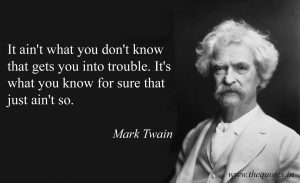Many projects need nothing more than a project team and a steering committee made up of local sponsors when it comes to the governance structure. But if you need to implement in more than one location, it helps to have someone there to champion that change for you. And if you have to roll out across several locations, you want to have a network of these change champions.
Change champions can make your life so much easier when implementing a project, especially one that creates a lot of change (and is therefore probably somewhat unpopular).
I learned this lesson early on in my career when I was helping to implement an Oracle solution to 5 business units across North America. The project was successful, but I was burned out! I had worked regular 65-80 hour weeks for over 7 months. I asked my wife whether she minded that my next gig would involve travel and we might see each other less. Her response? “Sure, go ahead. Me and the kids don’t see you now anyways.” And my project was only 15 minutes from my home! Ouch!
The next project involved rolling out an SAP solution across multiple manufacturing and sales/marketing locations across Canada, with close coordination with a North American and global rollout. There I was introduced to the concept of a change network.
OMG! What a difference that made! I still worked hard, but was able to have a life and see my wife and kids (other than when they were sleeping). Having change champions made a big difference.
The Champion Difference
So, how is a change champion different from a project team member or a local sponsor?
A project team member is your worker bee. They are usually selected because they have strong technical skills, understand their area of the business well, and are competent. Sometimes team members are selected because they are just plain available (read: not very good at their job), but that is the subject of another blog. Or, more likely, a rant.
A local sponsor, usually a senior manager who also sits on a project committee, is there because they can make decisions and can clear roadblocks. In other words, they command respect, and hopefully it’s more than just because they can wield a stick.
But a change champion is somewhere in-between.
They also have technical skills, like your project team member. But they also have higher than average EQ and good relationships with people in their area. Often they are up-and-coming junior managers or experienced middle managers. On occasion a project team member can act as a change champion also, but that is more the exception than the rule.
They are also respected and can reduce resistance like the local sponsor, but not because of organizational power. They are respected because of their deep understanding of their business and the strength of their relationships.
And that is their biggest advantage when rolling out in different locations (or even in the same location with large departments). They are attuned to their local micro-culture and know what works and doesn’t, and how to make things work when they don’t.
That’s important because usually we make some assumptions about how things work across an organization (we have to, there is only so much time). And then we can get into trouble, as Mark Twain so nicely said it.
Also, because of the strength of their relationships, they can sway people onto your side. More importantly, they can sway people to do some of the heavy lifting for you! And that can be worth gold!
Getting Your Change Champions
OK then, how do you go about getting change champions and if necessary, setting up a change network? Here are the steps that work for me, with some bonus materials for you if you think this will be helpful to you.
Step 1: Identify potential change champions
I cannot stress enough that these have to be the ‘right’ people. They have to have particular characteristics that makes them valuable for this role. You are far better off having no change champion than having the wrong person in this job.
I use a 12 point checklist to select change champions for my projects. Rather than get into each characteristic here, you can download the actual checklist I use right here for free, and sign up to receive this blog as a bonus: Change Champion Checklist.
Step 2: Convince management to enlist change champions
This requires laying out why you need change champions, what they have to do (in addition to what they themselves, and the project team, are doing), and what the time commitment is going to be. If it is a larger implementation, you will need to convince them of setting up a more formal change network.
Again, rather than getting into all of the details here and stretching this blog into a book, I have put the slides that I use into a link you can download for free as well! Once you get the checklist I will send you an email with an attachment of the presentation as an additional bonus.
Step 3: Conduct onboarding or contracting meetings with your change champions
 Once an individual has been told they are going to be a change champion on your project (usually by someone on the steering committee), they will naturally be somewhat confused and suspicious. So you have to reach out to them and focus on sharing these key points:
Once an individual has been told they are going to be a change champion on your project (usually by someone on the steering committee), they will naturally be somewhat confused and suspicious. So you have to reach out to them and focus on sharing these key points:
- Let them know why you need them, and only them. They need to understand they are valuable, special, because they are.
- Thank them for accepting that they have been voluntold, and let them know how much you and the team genuinely appreciate that they are on board. Tell them that being a change champion is considered positive for their status.
- Empathize with the added duties of this role. Acknowledge that they are already very busy (there people tend to be, that’s what makes them so great for this role) and acknowledge that being a change champion will add to their workload. Be honest.
- Reassure them that you will do everything in your power to respect their time, and use them very selectively so as not to burden them unnecessarily. But, don’t over-promise.
- Then, and only then, let them know what you expect/hope to get from them, including time commitments. Here you need to be specific (e.g., weekly 30 minute meetings, 60 minutes weekly, on average, to communicate with people in their location, etc.). As part of this, answer any questions they may have.
- Finally, ask them for their personal commitment to be a change champion. Don’t leave the meeting without this.
- Close the meeting by thanking them again, reiterating their importance, and how you are going to value their time and contribution.
- Respectfully get up and leave.
Step 4: Set up and run change network meetings
 If you only have one or two change champions, use one-on-one regularly scheduled meetings. Once you get to 3 champions or more, you have a change network on your hands, and then it’s better to have one meeting with everyone in the room (or most likely on a webinar or call).
If you only have one or two change champions, use one-on-one regularly scheduled meetings. Once you get to 3 champions or more, you have a change network on your hands, and then it’s better to have one meeting with everyone in the room (or most likely on a webinar or call).
Here are the guidelines I use with my teams when running Change Network meetings:
- Use tight time boxing, and be super disciplined here. If the meeting runs short, end it right away. Otherwise end the meeting right on schedule regardless. This is the #1 way to signal to people that their meeting time is valuable.
- Focus on accountabilities, decision and critical tasks, not information. If Change Champions begin to feel that this is just status regurgitation and small talk to fill time or make you feel important, they will drop off faster than leaves in an October windstorm.
- Schedule regular meetings so they are in everyone’s calendar. It has to feel part of your Change Champions’ regular routine. Plus, you can always cancel if there is nothing to cover, although that should happen only rarely.
- Have a standard, predictable agenda so that people know what to expect each time. Here is the 3 point agenda we use:
- Actions: what we need you to do as Change Champion (that’s after all why they’re there).
- Alerts: risks and issues coming up that may require you to reach out to the Change Champions.
- Updates: Information which really has to be important and relevant to them.
In short, it actually takes hard work to prepare for each meeting. But the proof is in the results you are going to get.
Final Words to the Wise
Of all the project roles, this is the most ‘volunteer-like’. It’s not really a formal project role. Change Champions can decide to back off and there is little that you can do force them back. You are dependent on their discretion of whether they want to truly help. Change Champions are fickle and finicky, but can make your life so much easier, and your project really successful.
The reasons are that companies have micro-cultures that vary by location and frequently department. People trust their own: there are local stars, and it’s valuable to take advantage of this human trait. And finally, everyone wants to feel special. Being acknowledged as a group by having a special representative is a win for adoption.
Good luck with getting your change champions, and setting up your change network.
Like this blog? Share it with your colleagues. And sign up and you won’t miss another one!
Image by Gerd Altmann from Pixabay














